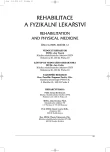MRI – Identification of Changes in Pelvic Shape
Authors:
P. Bendová 1; M. Fričová 2; M. Tichý 1; Z. Seidl 3; I. Špringrová 1; Š. Horáčková 1; D. Pánek 1
Authors‘ workplace:
Katedra fyzioterapie, Katedra anatomie a biomechaniky FTVS UK, Praha
vedoucí doc. PaedDr. D. Pavlů, CSc. a prof. ing. S. Otáhal, CSc.
1; Ústav mechaniky, Odbor pružnosti a pevnosti, ČVUT, Praha
vedoucí prof. ing. S. Konvičková, CSc.
2; Radiodiagnostická klinika 1. LF a VFN, Praha
vedoucí doc. MUDr. J. Daneš, CSc.
3
Published in:
Rehabil. fyz. Lék., 12, 2005, No. 2, pp. 86-90.
Category:
Original Papers
Overview
The effort of this project is to identify by MRI intraindividual changes in pelvic region topography and to compare those changes with clinically described pelvic shape change called fixed pelvic nutation, optionally to add certain facts. The trial sample is made from two groups of female subjects. The group a) involves patients with dg. – coccygeal syndrom, shape change is induced by terapheutical input. Healthy women create group b). Fixed nutation is artificially evocated by surface electrostimulation of pelvic floor muscles. In the frame of pilot study (1 subject from each group) bone edge coordinates are achieved and imported into graphical software. Simple 3D models are created for better spatial image and also set of pelvimetry and distance measurements in state „before” and „after” are done. Evaluation of the pilot study shows certain congruence with clinical knowledge – in case of group a) qualitative and in case of group b) rather quantitative character.
Key words:
magnetic resonance imaging, pelvis, pelvic floor muscles, electrostimulation, fixed pelvic nutation
Labels
Physiotherapist, university degree Rehabilitation Sports medicineArticle was published in
Rehabilitation & Physical Medicine

2005 Issue 2
Most read in this issue
- Painful Dysfunction Syndromes of the Shoulder: The Role of Short Depressors of the Humeral Head
- Standing up from the Sitting Position in Clinical Practice
- McKenzie Mechanical Diagnosis of Functional Syndromes of the Musculoskeletal System
- Dynamics of Functional Muscle Changes in Young Tennis Players
